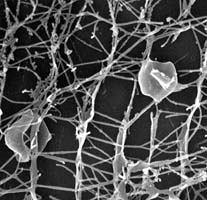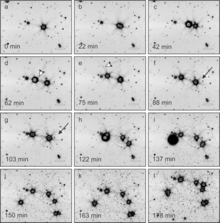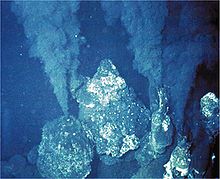Pyrodictium abyssi
Classification
Archaea (Domain); Crenarchaeota (Phylum); Thermoprotei (Class); Desulfurococcales (Order); Pyrodictiaceae (Family); Pyrodictium (Genus)
Species
|
NCBI: Taxonomy |
Pyrobacterium abyssi (Species)
Description and Significance
Pyrodictium abyssi is a gram negative, hyperthermophilic, anaerobic archaeon. This archaeon was first isolated in 1991 by Pley and Stetter. It was isolated from heat vents deep in the ocean called black smokers, which are formed as a result of volcanic activity deep beneath the ocean floor [8]. P. abyssi are capable of growing in temperatures ranging from 80-110oC but have maximum growth between 97-105oC and are capable of survival in an autoclave for up to an hour. Optimally, P. abyssi thrive at a pH of 5.5 but have been found to survive anywhere from 4.7-7.1. P. abyssi are capable of growing in NaCl concentrations ranging from .7-4.2% and are strictly anaerobic [3]. This archaeon is disc shaped and approximately .3-2.5µm in diameter and are .025-.05µm thick. P. abyssi grows in an extensive 3D network composed of cells and cannulae, which are hollow, extracellular tubules with a diameter of about 25nm. The cannulae bundle together to allow multiple cells to be connected [7]. This archaeon is a chemolithoautotroph and uses Hydrogen as an electron donor and Sulfur as an electron acceptor to perform inorganic redox reactions in extreme conditions. This archaeon could prove extremely useful in industrial biotechnology because it has been found to possess enzymes such as chaperone proteins and ATP synthase which are functional at high temperatures instead of denaturing [3].
Genome Structure
The genome has not yet been sequenced, but using relationships between various hyperthermophiles with respect to their size, their structural organization and their phylogenetic relationship based on the content of the respectetive 16rDNA genes it is determined the entire genome of pyrodictium abyssi is a single circular chromosome and approximately 1.6Mb[1]. It is very similar to Hyperthermus butylicus (97% sequence coverage) and Pyrodictium occultum (96% sequence coverage), which is another sulfur reducing hyperthermophile belonging to the same genus. Both BLAST hits had E-values of 0 meaning there is essentially a zero chance to find a score as good.
Cell Structure, Metabolism and Life Cycle
Pyrodictium abyssi is a gram-negative bacteria that displays normal cell wall functions, but interesting features stem from the cell during cell growth. Pyrodictium abyssi grows in the form of a macroscopically visible network. It consists of cells entrapped in an extracellular matrix of hollow tubules, the “cannulae". One cannula penetrates the periplasmic space and the other cannula contacts the surface of the cell[6]. This indicates that the cannulae interconnect individual cells with each other on the level of their periplasmic space, but not into cytoplasmic membrane possibly attributing to its stability. Although the function of the cannulae still remains unknown, the linkage by cannulae therefore could enable cells to exchange metabolites, genetic information, or signal compounds[4].
Pyrodictium abyssi is a chemolithiautotroph that gains energy from sulfur respiration utilizing hydrogen as an electron donor. The membrane bound respiratory chain from H2 to sulfur generates an electrochemical proton potential, which drives chemiosmotic ATP synthesis via an H+-translocating ATP synthase. Archaeal ATPase/synthases are classified as A-type ATPases[2]. The membrane bound sulfur reducing complex is also comprised of nine major polypeptides including a hydrogenase, sulfur reductase, an electron-transport chain. The known components of the ETC are a cytochrome c, two additional cytochromes, but no quinone.
The only by-product found was Hydrogen sulfide, which can be beneficial to environments and ecosystems, but due to the isolation of Pyrodictium abyssi this production is probably irrelevant.
Ecology and Pathogenesis
Pyrodictium abyssi are found deep below the ocean’s surface in hydrothermal vents called black smokers. Black smokers produce a great amount of heat, methane, and sulfur compounds. P. abyssi and other archaea found in these thermal vents convert these products into energy by chemosynthesis and sulfur reduction. Additionally, P. abyssi and other Crenarchaeota were sampled for known autotrophic CO2 fixation pathways. Ribulose 1,5-bisphosphate carboxylase activity was detected in P. abyssi, which is important in the first step in Carbon fixation in the Calvin cycle. Phosphoribulokinase activity (which is also important in Carbon fixation) was not detected and operation of the Calvin cycle remains to be demonstrated so perhaps they are using a modified version of the Calvin cycle for fixation and reduction of Carbon [5].
Pyrodictium abyssi is not a pathogenic archaeon and has not been documented of causing any disease. It poses no threat to humans because of its extreme living conditions and even in a laboratory setting, the temperature would kill the archaeon before it had a chance to come in contact with a human.
References
[1] Baumann C, Judex M, Huber H, Wirth R. “Estimation of genome sizes of hyperthermophiles.” Extremophiles. 1998 May;2(2)p. 101-8.
[2] Dirmeier R, Hauska G and Stetter K. “ATP synthesis at 100°C by an ATPase purified from the hyperthermophilic archaeon Pyrodictium abyssi.” Febs Letters. 4 February 2000, Volume 467, Issue 1, p. 101-104.
[3] Egorova, K., and Antranikian, G. “Industrial relevance of thermophilic Archaea”. Current Opinion in Microbiology. 2005. Volume 8. p. 649-655.
[4] Horn C, Paulmann B, Kerlen G, Junker N, and Huber H. “In Vivo Observation of Cell Division of Anaerobic Hyperthermophiles by Using a High-Intensity Dark-Field Microscope.” Journal of Bacteriology, August 1999, Vol. 181, No. 16, p. 5114-5118.
[5] Hugler, M., Huber, H., Stetter, K., Fuchs, G. “Autotrophic CO2 Fixation Pathways in archaea (Crenarchaeota)”. Arch Microbiology. 2003. Volume 179. p. 160-173.
[6] Nickell S, Baumeister R and Reinhard R. “Pyrodictium cannulae enter the periplasmic space but do not enter the cytoplasm, as revealed by cryo-electron tomography.” Journal of Structural Biology. Volume 141, Issue 1, January 2003, Pages 34-42
[7] Rieger, G., Rachel, R., Hermann, R., and Stetter, K. “Ultrastructure of the Hyperthermophilic Archaeon Pyrodictium abyssi”. Journal of Structural Biology. 1995. Volume 115. p. 78-87.
[8] Takai, K., Komatsu, T., Inagaki, F., and Horikoshi, K. “Distribution of archaea in a black smoker chimney structure”. Applied Environmental Microbiology. 2001. Volume 67. p. 3618-3629.
Author
Page authored by Ronald Stern and Hillary Szczepaniuk, students of Prof. Jay Lennon at Michigan State University.
<-- Do not remove this line-->



